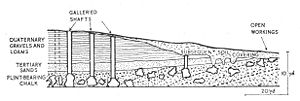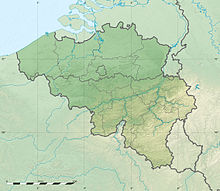- Neolithic flint mines of Spiennes
-
Neolithic Flint Mines at Spiennes (Mons) * UNESCO World Heritage Site
Section of mines at SpiennesCountry Belgium Type Cultural Criteria i, iii, iv Reference 1006 Region ** Europe and North America Coordinates 50°25′11.96″N 3°58′57.27″E / 50.4199889°N 3.982575°ECoordinates: 50°25′11.96″N 3°58′57.27″E / 50.4199889°N 3.982575°E Inscription history Inscription 2000 (24th Session) * Name as inscribed on World Heritage List
** Region as classified by UNESCOThe Neolithic flint mines of Spiennes are Europe's largest and earliest neolithic mines, located close to Walloon village of Spiennes, southeast of Mons, Belgium. The mines were active during the mid and late Neolithic (4400-3000 BC). The site and its surroundings were added to the UNESCO's list of World Heritage Sites in 2000.
Contents
Description
It is well known for its flint mines,[1] which are on the list of UNESCO World Heritage Sites since 2000. The entry on the list describes them as "the largest and earliest concentration of ancient mines in Europe" and cites the level of human technological development they demonstrate as justification for their inclusion.[2]
The mines cover some 100 hectares of downland near Mons in Belgium and are interesting for showing the transition between opencast and underground mining for the flint nodules. The nodules were extracted using deer antler picks. The stones were then knapped into rough-out shapes of axes, and finally polished to achieve the final state.
The rough-outs were traded over a wide area, and were often polished at their destination. Polishing strengthens the final product, making the axe-head last longer. The axes were used initially for forest clearance during the early Neolithic period, and for shaping wood for structural applications, such as timber for huts and canoes.
Neolithic mines of SpiennesDeer antler pick (Grimes Graves)Late Stone Age flint axe, about 31 cm longOther sites
The site is comparable with Grimes Graves and Cissbury in the United Kingdom, which were also sources of flint. Other hard rocks were used for making polished stone axes however. There are many locations in Britain where fine-grained igneous or metamorphic rocks were collected from screes or mined opencast, then roughed out locally before trading on to other parts of the country. Examples include the Langdale axe industry, Penmaenmawr and Tievebulliagh.
See also
- Cissbury
- Flint
- Grimes Graves
- Stone axe
- Michelsberg Culture
References
- Citations
- ^ "Neolithic Flint Mines of Petit-Spiennes : Official web site". http://www.minesdespiennes.org/en.html. Retrieved 2007-12-16.
- ^ "Neolithic Flint Mines at Spiennes (Mons)". World Heritage List. UNESCO. 2000. http://whc.unesco.org/en/list/1006/. Retrieved 2007-03-16.
- Bibliography
- C. Guillaume, Ph. Lipinski & A. Masson: Les mines de silex néolithiques de la Meuse dans le contexte européen. Musées de la Meuse, Sampigny 1987. (French)
- F. Gosselin: Un site d'exploitation du silex à Spiennes (Hainaut), au lieu-dit "Petit-Spiennes". Vie archéologique 22, 1986, 33-160. (French)
- F. Hubert: Une minière néolithique à silex au Camp-à-Cayaux de Spiennes. Archaeologia Belgica, 210, 1978. (French)
- F. Hubert: L'exploitation préhistorique du silex à Spiennes. Carnets du Patrimoine n°22. Ministère de la Région wallonne, Direction générale de l'Aménagement du Territoire, du Logement et du Patrimoine, Namur 1997. (French)
- R. Sheperd: Prehistoric Mining and Allied Industries. (Academic Press, London 1980).
- Société de recherches préhistoriques en Hainaut: Minières néolithiques à Spiennes (Petit-Spiennes). 1997 (French)
- ICOMOS evaluation
- Collet, Hélène (2004) (in French). Les mines néolithiques de Spiennes : état des connaissances et perspectives de recherche. Section 10: The Neolithic in the Near East and Europe. Oxford: Archaeopress. ISBN 1841716537. http://minesdespiennes.org/textes/spiennes.etatdesconnaissances.hcollet.pdf. Retrieved 27 July 2011. "Actes du XIVème congrès UISPP, Université de Liège, Belgique, 2 - 8 septembre 2001"
External links
 Media related to Spiennes at Wikimedia Commons
Media related to Spiennes at Wikimedia Commons
World Heritage Sites in Belgium Brussels Flanders Belfries of Belgium and France1 · Bruges (historic centre) · Flemish Béguinages · Plantin-Moretus House-Workshops-Museum ComplexWallonia Belfries of Belgium and France1 · Four Lifts on the Canal du Centre and their Environs, La Louvière and Le Rœulx, Hainault · Neolithic flint mines at Spiennes · Notre-Dame Cathedral of Tournai1 Shared locally with other regions and with FranceCategories:- World Heritage Sites in Belgium
- Neolithic
- Wallonia's Major Heritage
- Prehistoric mines
- History of Wallonia
- Prehistoric sites in Belgium
Wikimedia Foundation. 2010.




